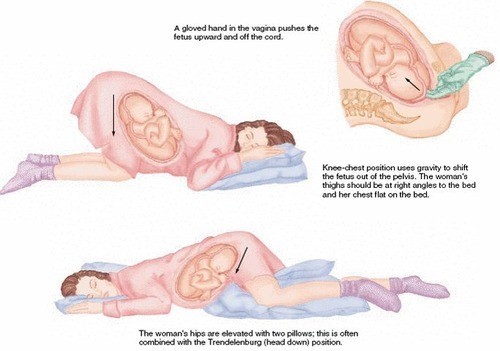A pregnant woman's amniotic membranes rupture and a prolapsed umbilical cord is found. What intervention would be the first priority?
Placing the woman in the knee-chest position.
Starting oxygen by facemask.
Preparing the woman for a vaginal birth.
Covering the cord in sterile gauze soaked in saline.
The Correct Answer is A
In the case of a prolapsed umbilical cord, the first priority intervention is to relieve pressure on the cord. Placing the woman in the knee-chest position or Trendelenburg position with the hips elevated is the best way to achieve this. This position helps to reduce the compression of the cord and improve fetal oxygenation.
Option B is incorrect because while oxygen may be necessary, relieving pressure on the cord is the priority.
Option C is incorrect because a vaginal birth should not proceed with a prolapsed umbilical cord, as it can cause cord compression and fetal distress.
Option D is incorrect because covering the cord in sterile gauze soaked in saline is not a priority intervention and may not be effective in relieving pressure on the cord.

Nursing Test Bank
Naxlex Comprehensive Predictor Exams
Related Questions
Correct Answer is B
Explanation
Environmental health is concerned with the impact of environmental factors on human health, including physical, chemical, biological, and social factors. By improving environmental health in a community, we can decrease exposure to environmental hazards and reduce the incidence of environmentally related diseases, resulting in improved health outcomes.
One of the most important outcomes of environmental health interventions is increased life expectancy for the community. By reducing exposure to environmental hazards, such as air pollution, water pollution, and toxic chemicals, we can decrease the incidence of environmentally related diseases, such as respiratory disease, cancer, and neurological disorders. This, in turn, can increase life expectancy and improve the overall health of the community.
Correct Answer is A
Explanation
The recovery phase of a disaster is the period when the immediate danger has passed, and the focus shifts to restoring the affected area to its pre-disaster state. The hallmark activities during this phase include the evaluation of the disaster plan, as well as cleanup and rebuilding efforts to help affected individuals and communities recover from the disaster's effects. The recovery phase can last for weeks, months, or even years, depending on the severity and extent of the damage caused by the disaster.

Whether you are a student looking to ace your exams or a practicing nurse seeking to enhance your expertise , our nursing education contents will empower you with the confidence and competence to make a difference in the lives of patients and become a respected leader in the healthcare field.
Visit Naxlex, invest in your future and unlock endless possibilities with our unparalleled nursing education contents today
Report Wrong Answer on the Current Question
Do you disagree with the answer? If yes, what is your expected answer? Explain.
Kindly be descriptive with the issue you are facing.
